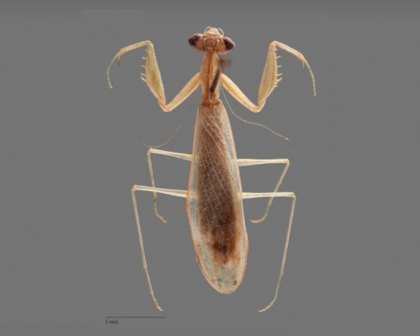Bug named in honor of Ruth Bader Ginsburg

The new species from Madagascar was named for the Supreme Court associate justice “in honor of her commitment to women’s rights and gender equality,” said lead author Sydney Brannoch, a doctoral candidate at Case Western Reserve University working with the Cleveland Museum of Natural History, in a museum video. Officially, the species is Ilomantis ginsburgae (ill-oh-mantis ginnz-BURG-ee).
Significantly, the species was identified using a new method that establishes a female genitalia character system. Male genitalia characters have historically been used in classifying insect species, according to a news release from the Cleveland Museum of Natural History.
Brannoch and co-author Gavin Svenson, also of the Cleveland Museum of Natural History and Case Western Reserve University, published their research in the journal Insect Systematics & Evolution.
SATELLITES FOCUS ON POLLUTION: Scientists have used satellites to zero in on unreported man-made pollution sources.
Through satellite data, researchers identified 39 unreported and “major human-made sources of toxic sulfur dioxide emissions,” according to a NASA news release. Sulfur dioxide (SO2) is regulated by the U.S. Environmental Protection Agency and contributes to acid rain.
Researchers from NASA, Environment and Climate Change Canada, and two universities analyzed satellite data from 2005 to 2014 and discovered the unreported sources in clusters of coal-burning power plants, smelters and oil and gas operations, notably in the Middle East, but also in Mexico and parts of Russia.
They also found discrepancies in the amount of emissions already reported. Unreported and under-reported sources account for about 12 percent of all human-made emissions of sulfur dioxide.
The University of Maryland, College Park, and Dalhousie University in Halifax, Nova Scotia, contributed to this study.
During in-depth interviews with 17 college athletes, a North Carolina State University researcher found that the students felt they “had to express mental toughness and feelings of gratitude about the opportunity to participate in college sports, regardless of what was happening in their personal lives -- such as the illness or death of family members,” a university news release said.
Researchers refer to this as emotional labor -- the requirement that an individual display certain emotions. For example, employees at an amusement park must be cheerful and polite.
In this case, student athletes turn to teammates for emotional support.
The researcher, Lynsey Romo, is an assistant professor of communication at North Carolina State and author of the research, "College Student-Athletes' Communicative Negotiation of Emotion Labor," published in the journal Communication and Sport.
Related:
Scientists name spider after Johnny Cash
The notorious R.B.G. gift guide
Clean Power Plan takes aim at pollution
Sports: A history rich in scandal
If you would like to comment, give us a shout, or like us on Facebook and tell us what you think.

